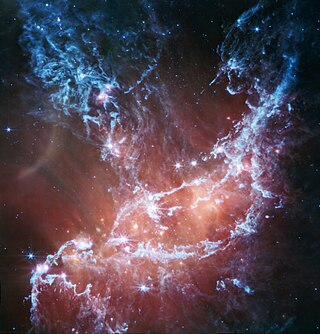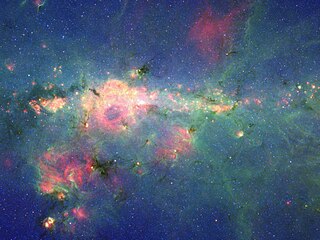
The Arches Cluster is the densest known star cluster in the Milky Way, about 100 light-years from its center in the constellation Sagittarius, 25,000 light-years from Earth. Its discovery was reported by Nagata et al. in 1995, and independently by Cotera et al. in 1996. Due to extremely heavy optical extinction by dust in this region, the cluster is obscured in the visual bands, and is observed in the X-ray, infrared and radio bands. It contains approximately 135 young, very hot stars that are many times larger and more massive than the Sun, plus many thousands of less massive stars.

NGC 346 is a young open cluster of stars with associated nebula located in the Small Magellanic Cloud (SMC) that appears in the southern constellation of Tucana. It was discovered August 1, 1826 by Scottish astronomer James Dunlop. J. L. E. Dreyer described it as, "bright, large, very irregular figure, much brighter middle similar to double star, mottled but not resolved". On the outskirts of the cluster is the multiple star system HD 5980, one of the brightest stars in the SMC.
HD 162020 is a star in the southern constellation of Scorpius with a likely red dwarf companion. It has an apparent visual magnitude of 9.10, which is too faint to be visible to the naked eye. The distance to this system is 102 light-years based on stellar parallax. It is drifting closer to the Sun with a radial velocity of −27 km/s, and is predicted to come to within ~18 light-years in 1.1 million years.

WR 102ka, also known as the Peony star, is a slash star that is one of several candidates for the most luminous-known star in the Milky Way.

Cygnus OB2 is an OB association that is home to some of the most massive and most luminous stars known, including suspected Luminous blue variable Cyg OB2 #12. It also includes one of the largest known stars, NML Cygni. The region is embedded within a wider one of star formation known as Cygnus X, which is one of the most luminous objects in the sky at radio wavelengths. The region is approximately 1,570 parsecs from Earth in the constellation of Cygnus.
63 Ophiuchi is an O-type giant star in the constellation Sagittarius, despite its name. During a 2009 survey for companions of massive stars, it was observed using speckle interferometry but no companion was found. The small parallax measurement of 0.91±0.09 mas suggest that this extremely luminous star may be located about 3,600 light-years away. An estimate of the distance based on the strength of the Ca II line yields a more modest value of 2,605 ly (799 pc). The star lies only 0.3° north of the galactic plane.

9 Sagittarii is a massive binary star in the constellation Sagittarius. It has an apparent magnitude of 5.97. Both components are highly luminous O-type main-sequence stars.

HD 168625 is a blue hypergiant star and candidate luminous blue variable located in the constellation of Sagittarius easy to see with amateur telescopes. It forms a visual pair with the also blue hypergiant HD 168607 and is located to the south-east of M17, the Omega Nebula.

Sigma Cygni, Latinised from σ Cygni, is a blue supergiant star in the constellation Cygnus. Its apparent magnitude is 4.2. It belongs to the Cygnus OB4 stellar association and is located approximately 3,300 light years away from Earth.

Westerhout 43, also known as W43, is a region of star formation of our galaxy located in the constellation of Aquila at a distance of 6 kilo-parsecs of the Sun, that is considered the region of the Milky Way that is most actively forming stars. Despite this, however, it is so heavily obscured by the interstellar dust that it is totally invisible in the optical and must be studied using other wavelengths that are not affected by it, such as the infrared or the radio waves.

Westerhout 31, also known as W31, is a complex of star formation regions of the Milky Way located in the constellation of Sagittarius.
BD+43 3654 is a massive luminous blue supergiant runaway star in the constellation Cygnus.

HD 34989 is a blue-white star in the main sequence, of apparent magnitude 5.80, in the constellation of Orion. It is 1700 light-years from the Solar System.
Westerhout 49-2 (W49-2) is a very massive and luminous star in the H II region Westerhout 49. At a mass of 250 solar masses and a luminosity of over 4 million L☉, it is one of the most massive and most luminous known stars.

V1936 Aquilae is a blue supergiant and candidate Luminous blue variable located in the nebula Westerhout 51, in the constellation Aquila, about 20,000 light years away. The star was originally identified as a massive star in 2000, and was thought to be an O-type supergiant. However, subsequent analyses have shown it to be not O but B-type, as well as being possibly an LBV.











